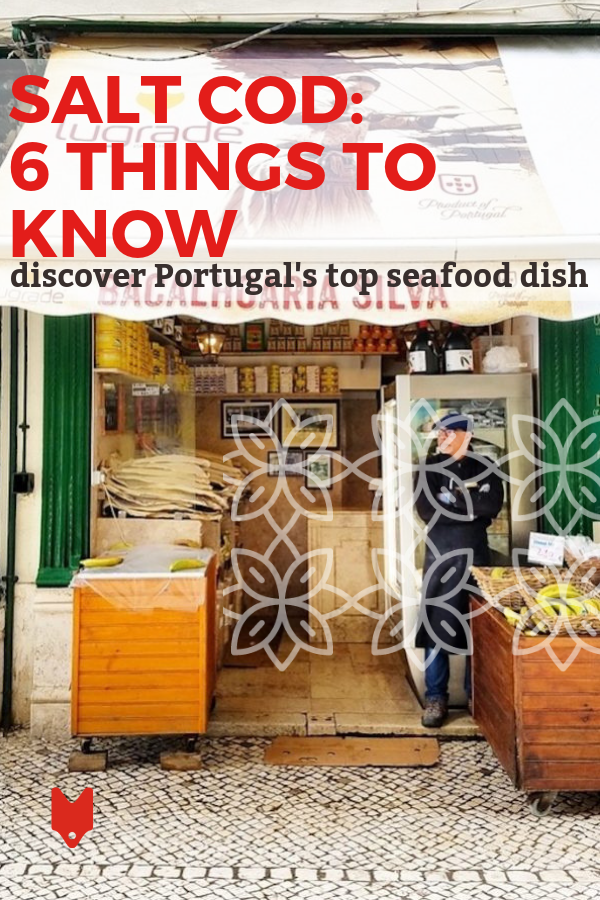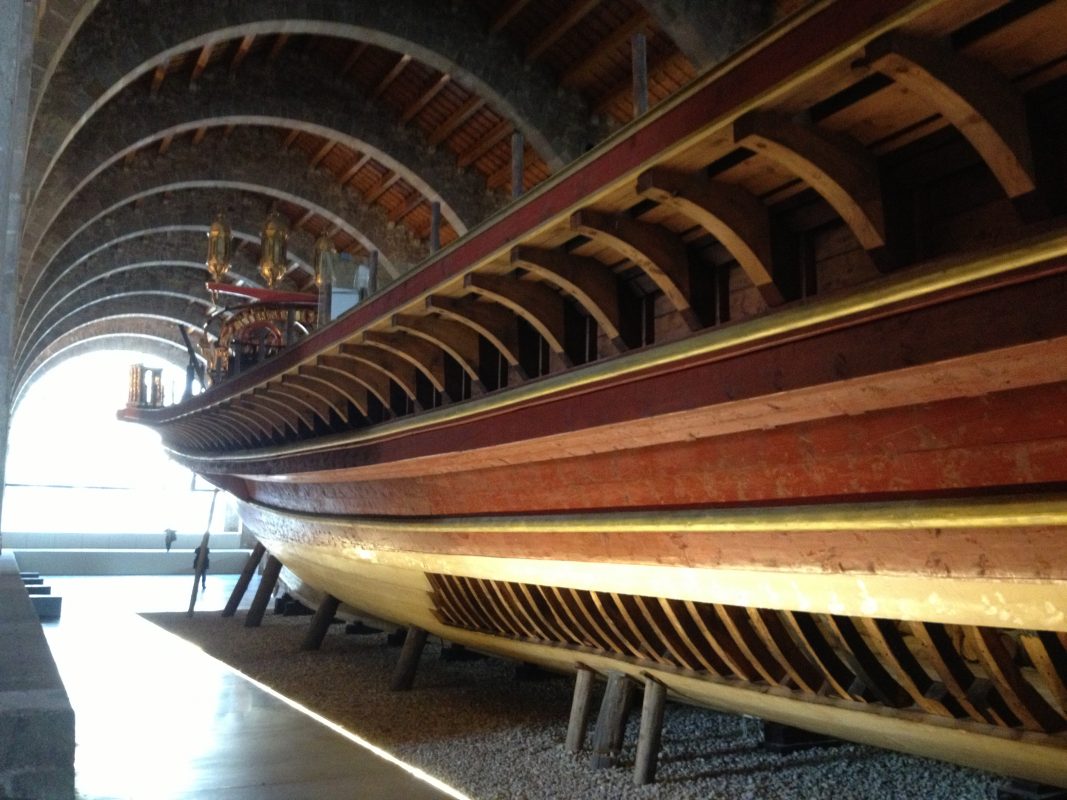This post is part of our Behind the Bite series, deep dives into the dishes that we can’t stop thinking about.
Portugal may be known for delicacies that come straight from the sea, but its most famous seafood is far from fresh.
If you’ve spent any time in Lisbon, you’ve probably encountered a common menu item that pops up everywhere from street food stands to swanky restaurants. It’s called bacalhau, salt cod, and if there’s one fish that represents Portuguese cuisine, this is it.

What is bacalhau?
The literal translation of bacalhau is salt cod, meaning codfish that has been heavily salted and dried to preserve it. You can buy it all over Portugal in markets and grocery stores, rock solid and ready to withstand even the hottest Lisbon summer—no refrigeration required.
Before it’s cooked, the dried fish is rehydrated by soaking in water for several hours—even days—and then shredded or sliced. Some people like to say that there are 365 ways to cook salt cod—one for each day of the year. Others claim that the Portuguese have at least 1,000 ways to serve it.

Salt cod forms the base of dozens of classic dishes, and lots of Portuguese families even eat it for Christmas dinner. It’s so closely linked to the national identity that many people never think to question its ubiquity. But upon taking a closer look at its history, bacalhau becomes even more interesting…
The origins of salt cod in Portugal
One of my favorite things about Lisbon is the seafaring spirit that suffuses the city—and the country, for that matter. It’s no wonder, considering that Portugal is located right on the edge of mainland Europe, and that many of its most famous historical figures were sailors and explorers.
Those explorers were the ones who introduced salt cod into Portuguese cuisine, after discovering vast amounts of the fish near Newfoundland and Norway. Yes, you read that right: Portugal’s most iconic seafood isn’t locally sourced, and never has been. You won’t find any cod swimming along its coasts—so why is it such an enormous part of the local cuisine?

Back in the 1500s, salting and drying fish was the best way to preserve it for future use. But fish that have too much oil and fat in their flesh—like sardines, for example—aren’t ideal, as these substances keep the salt from preserving the fish.
Cod, however, have very low levels of oil and fat, making them the perfect portable source of nutrition. When Portuguese sailors started bringing bacalhau back home, it was plentiful and cheap—and within a few decades, it was firmly entrenched in the national culinary identity.
Where does salt cod stand today?
Good salt cod isn’t exactly cheap anymore—prompting some people to forego the real stuff in favor of frozen substitutes. In fact, you might wonder why the Portuguese would spend so much money to import fish all the way from Scandinavia, when they have direct access to some of the world’s freshest seafood.
In this case, cultural significance simply trumps convenience and cost. For better or for worse, bacalhau is an essential item in every bakery, café and household in the country. It comes in all forms imaginable, but there are a few variations that you’ll find again and again. These are the mainstays and must-tries that should be at the top of your list.
The best bacalhau-based dishes
First up, pasteis de bacalhau. These simple treats consist of shredded salt cod, potatoes, eggs, parsley and onion, shaped into spheres and deep fried. They’re a staple of every neighborhood bar, and figure prominently on the menus of even the fanciest eateries. Lisbon’s aptly named Casa Portuguesa do Pastel de Bacalhau adds a unique twist with Serra da Estrela cheese.
Another common dish is bacalhau à Brás, in which pieces of salt cod are tossed with potatoes, scrambled eggs and black olives. It may sound like a weird combination, but one bite and you’ll become a believer. There’s something about the way the flavors mix that’s totally addictive—trust me. To try a trendy twist on this recipe, head to Casa Lisboa.

Finally, there’s bacalhau com natas. If you thought bacalhau à Brás was rich, wait until you try this concoction of salt cod, potatoes, onions and cream. The ingredients are layered and baked in the oven until the top turns nice and brown. You won’t find many dairy-based main dishes in traditional Portuguese cooking, but this is undoubtedly a classic.
If you want to sample some of the best salt cod in Portugal—in all its many forms—I suggest you pay a visit to A Casa do Bacalhau, just outside Lisbon. Or if you’d rather try cooking it yourself, check out this recipe for creamy salt cod croquettes!
What bacalhau means to me—a personal story
The first time I sampled Portuguese salt cod, it was actually kind of an accident. I was in a tiny café in the back of a shopping center, witnessing a weekly fado gathering. There was no one else under the age of 60 in the room, and certainly no other foreigners.
I was trying my best to enjoy the music while also ignoring my imposter syndrome and staying out of everyone’s way. At one point, the old man sitting next to me ordered a basket of pasteis de bacalhau… and then passed me one on a napkin. No words were exchanged: just a deep-fried ball of fish and a knowing smile.

I won’t lie; it was not the most delicious thing I’d ever eaten. But what I remember most about that little croquette (and the next one he insisted on sending my way) was not its taste or texture. It was the feeling I had while eating it: the feeling of being generously welcomed into someone else’s world, even when I felt like I had no business being there.
In a cramped little café, surrounded by people who could have been my grandparents—and who were singing their hearts out in a language I didn’t understand—this man found a way to communicate. To let me know that these people were willing to accept me into their circle for just a few hours. And all it took, funnily enough, was a bit of bacalhau.
The significance of salt cod
This will always be what I think of when I eat pasteis de bacalhau: the way that food can transcend languages, generations and borders to bring people together. Maybe that sounds like a lot of power to place on something so mundane, but I think this is exactly what makes salt cod so significant.
Are you coming to Lisbon?
Don’t waste a single meal—check out our ultimate foodie guide to
where to eat in Lisbon!
At its core, bacalhau is a representation of concepts much greater than itself. It not only symbolizes Portugal’s history of maritime exploration and culinary traditions, but also the way that a certain food can take on meaning for a particular place: even if it comes from miles—and oceans—away.
Learn the story behind more of Lisbon’s most iconic foods on our Tastes & Traditions of Lisbon Food Tour. We’ll take you to our favorite places, introduce you to our friends there, fill your belly with the best food & your mind with what it all means to Lisbon today.
Melissa first moved to Madrid to explore her interests in linguistics and communication, and quickly fell in love with the city’s culture and cuisine. She’s particularly passionate about Spanish vermouth and canned seafood, and makes it a point to drench absolutely everything in olive oil.